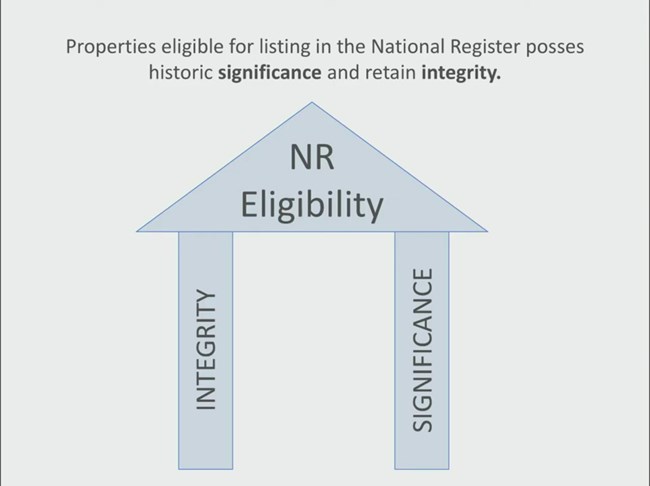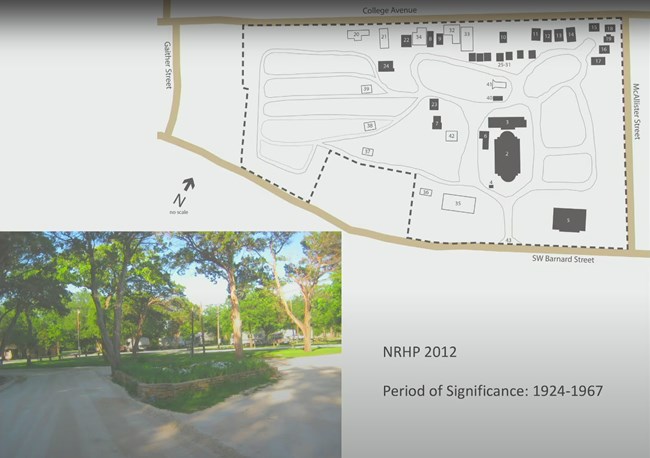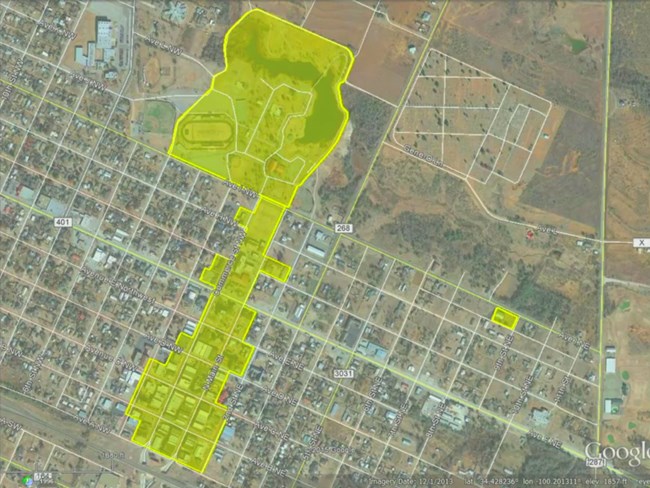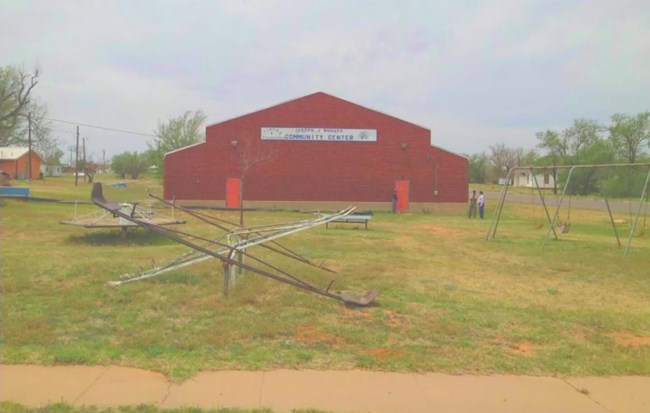Last updated: April 7, 2025
Article
Cultural Landscapes and the National Register of Historic Places
National Center for Preservation Technology and Training
This presentation, transcript, and video are of the Texas Cultural Landscape Symposium, February 23-26, Waco, TX. Watch a non-audio described version of this presentation on YouTube.

National Park Service
Greg Smith: I’m happy to participate in this program. I got really excited and I immediately made a list of all the different types of cultural landscapes that we've nominated and have seen listed and then I started getting into the specifics, all the properties that I wanted to feature.
We'll get right into it. I usually have this slide when I speak to a general audience about what the National Register is and today I don't have to do that, so that's wonderful. I'm going to really focus on, in this slide, about our philosophy because we have 50 SHPO's and I understand the program is a little different experience from state to state, but I want to give you some insight as to the Texas philosophy and how we run this program. It is an open process, which by regulation, I mean, that should be the case everywhere. In Texas, we embrace that and we invite people to participate. It's an open democratic process.
The best stories are coming from outside of our office, obviously. And anybody who comes to us who wants to take a shot at doing a National Register listing, we do everything we can to help them through the process. If somebody's going to take the effort to try, we want to make sure that they have a good chance of succeeding. So it's also a collaborative process because, as I said, we've been doing this for some time and so with an understanding of the regulations and the guidelines, we try to establish a strategy that the applicant can use in order to do best for the resource by really flushing out as fullest story as possible, and also get to what the main goal is, get that property listed.

Greg Smith, Texas Historical Commission
New ideas are encouraged. I love learning a new process or learning about a new property type. My friend Bert Bedeau the Nevada SHPO, you might know him, I've heard him say, "Those who don't push the envelope are doomed to lick it," which it's kind of silly, but who wants to lick the envelope? And so we're really open. When somebody comes to us with an idea for a property type or a strategy that we haven't done before, our first response isn't, "You can't do that," it's, "We haven't done that. Let's see, check with Parks Service, check with our colleagues in other States." And sometimes, I'm very happy to say, we're seeing new concepts in the National Register come through in some of the nominations that we do.
I don't have to go into a lot of detail about this. I can skip this cause we're running short on time. But in order to have the eligibility, you must have integrity, you must have significance. Integrity and significance relate directly to the resource type and so that's important. But I'll move on.

Greg Smith, Texas Historical Commission
Only one of four criteria must be met. Properties may be at local, state, or national significance. We have on the lower left, Mount Bonnell in Austin. Our nomination was for the good-sized park at the top of Mount Bonnell, which is an important, beloved overlook over the Colorado River. Chandor Gardens on the upper right, I'll go to in a little bit more detail and also Heritage Park Plaza in Fort Worth, by Lawrence Halprin.
I wanted to show some examples under each of these criteria. When I say one must be met, one criteria, often it's many. So for instance, Dealey Plaza in Dallas, obviously the site of the Kennedy assassination strong criteria A, significance there at the national level, but also significant as a major city beautification project on the West end of Dallas, essentially the front door to the County courthouse and so forth. The Alliance Municipal Golf Course in Austin we've done a couple of nominations for golf courses in Austin. This one is particularly important because it was the first integrated public golf course in the Southern United States in 1950. It's owned by UT, so there are some issues there, but we were successful in getting it listed. And also the Rhoads School in Childress, I'll go into it a little bit more detail.
Criterion B, we don't do a whole lot of criterion B nominations, but where it's applicable, we'll go with it. I'm going to show you more slides of the Chandor Gardens in Weatherford, which you must visit. Criterion C, distinctive design or physical characteristics. The example of the Rothko Chapel, which is an iconic internationally-known building, which was only about 30 years old when it was listed. We would never nominate a building, just its footprint, without taking into account the designed landscape. And the Barnett Newman sculpture, the broken obelisk, that's integral, part of the plan and part of the design, so there was no question to that.

Greg Smith, Texas Historical Commission
We just nominated the Trinity University campus, O'Neil Ford, Bartlett Cocke and Associates and the Sunken Garden Gate, which is part of a much larger district in Breckenridge Park. But the Sunken Garden Gate was first nominated individually as the work of Dionicio Rodriguez.
When we're looking at criterion C, it applies to vernacular landscapes as well. And this was one of the first farm nominations that I worked on and actually, it was a boundary increase. In the 1970s when the Strain Farm was nominated to the National Register, it was only the house. Not much farm to the house and they did not even include the outbuildings, where actually the farm work was done. In the 1990s, the owner Carol Strain-Burk, hired an archeologist, J. Blue, to do some investigations on the contoured fields, which were essentially built in the 1920s, as an experimental soil conservation project. And so this was a really great first project to work on, in nominating a farm, in that these fields had so much character. You can see them. This is a 1940s photograph of the fields and when you compare it, using Google Earth, you can see, those contours are still visible today. It's really an amazing place. But we would nominate the fields even if they weren't so clearly contoured and sculpted. They're almost a structure, in addition to being a site.
Then, criterion D is applicable obviously for archeological sites. This is the Dolores Crossing near San Antonio. We did a multiple property nomination for properties associated with Camino Real de los Tejas, with Michael Taylor at the National Parks Service.

Greg Smith, Texas Historical Commission
We don't have to belabor this, the five types of properties. And this is just part of my list of all the different property types that I think would have really high potential for having a significant cultural landscape. But as we heard in the boot camp on Sunday, for every building, there is a cultural landscape. I love that concept. And some other, like these built environments, these one-of-a-kind things; The Orange Show in Houston.
I'm going to go through some case studies to show you what we've been working on. This is just one of the properties that we nominated under the Camino Real multiple property form, the Onion Creek Crossings at McKinney Falls, which is seemingly untouched by man, although we know that's not true. But nary a building insight. And this was documented in the 17th century, as where Spanish explorers did cross the creek in the Austin vicinity. They described the waterfalls and here they are. A portion of McKinney Falls Park, that square, had already been listed as the McKinney Homestead. That was in 1974. And so what we nominated was a much larger area. The Camino Real, it's not a road, it's really a corridor with multiple paths and so forth. And so we didn't go as far to say, "This is where they trod and this is exactly where they crossed the falls." But within this park, there are multiple areas that were high potential for people to travel and certain points where they would have been able to cross.
Our boundary, it's shaped this way for a couple of reasons. One, within the confines of the park boundary. So for practicality, there are a lot of times where we would like to nominate a much larger landscape, but the reality of property ownership, private property, even public property, we have to make some concessions there and stay focused on what it is we're trying to get recognized. And so part of the boundary is very much shaped by the contours of the park. But also we wanted to include the two waterfalls, that were included in the park.
This is one of our great designed landscapes, Hare & Hare, the Fort Worth Botanic Garden. Hare & Hare out of Kansas City. This was prepared by Susan Klein of Fort Worth. You can see, I just show a few slides showing the concept drawing, aerial photograph at the time it was first constructed and then here it is at the time it was nominated.

Greg Smith, Texas Historical Commission
Heritage Park Plaza in Fort Worth, this is Lawrence Halprin. This is a bicentennial project and it wasn't completed until 1980. And so when you hear 50-year rule, it's not really a rule and rules are meant to be broken perhaps. There's a time and there's a place in order to do that. And so we're not going to be hemmed in by that artificial construct if it makes sense to go beyond that, and our Park Service staff agrees with us. So Lawrence Halprin, a great landscape designer here. It's on a bluff in Fort Worth, so it has many levels and like a lot of Halprin's work, it's a series of rooms, concrete water features and so forth. And this park was to address the establishment of Fort Worth on the bluff of the Trinity River.
All right. Chandor Gardens. Douglas Chandor was a portrait painter. He was English. He came to the United States and fell in love with an heiress from Weatherford, and then she got divorced, and then they got married. And as a wedding gift, they got this large acreage next to her mother's house. She wanted her to stay close. And so Douglas Chandor was a portrait artist. He was friends with the Roosevelts. He painted Winston Churchill, he painted Queen Elizabeth at the time of her coronation, and in Texas, he painted all the big names in oil and the editor of the Dallas Morning News owner, publisher Dealey. He ran in these circles with these really important people. Many of his portraits are in the National Portrait Gallery.
But he also said that he painted so he could earn money to build his garden. His garden is Texas' Kew Gardens and people generally don't recognize it for what it is, so you have to go to Weatherford. It's owned by the City of Weatherford. They're taking great care of it. It's interesting, his house and studio is in the center of it. But the house is just a part of this larger landscape. This is definitely one of those nominations where it's not about the house and the gardens, it's about the gardens. The house happens to be in there. It's a wonderful house by Joseph Pelich. And so here's an aero view. The boundary was the boundary of the owned parcel, that's owned by the city. It's in a residential area, a nice residential area.

Greg Smith, Texas Historical Commission
Chandor designed his garden in a series of rooms, actually a lot like Halprin designed his parks in a series of discrete rooms and Chandor did that as well. And it's hard to delineate on a map. When you're there, you know. You know you're in one room or another. And so we used the site plan that they provided and then we just assigned numbers for the general area because we didn't want to try to draw hard lines on these. The way the rooms are delineated, they're delineated by plantings, by walls. And so we wanted not to constrain it too much, until we described it room by room. And I just wanted to show you, there's an understanding, here's from the 1950s, what it looked like. Obviously, there've been some changes and actually, it went through some really hard times and so the plantings change. The City's doing what it can. It's not being restored, planting by planting. There's some plants that Chandor really loved that are just not working in the present environment.
Oakdale Park Historic District. This is a private park in Somervell County, which is on the Paluxy River. It's a beautiful setting. And so this was a private park and it had a swimming pool, cabins. One of the things that was really interesting about it, it had had pavilions and entertainment venues and so forth, was that the park was first developed in the 1920s, and it changed along with the expectations of what camping was. And so we got to a point where in the mid to late 1960s, that whole area to the west, which when you look at it on the ground, you see there are no buildings there. But that was really important because in order to sustain this as a business, they had to accommodate trailers and campers and so forth.
The question was, well, do we cut that out? It's not 50 years old, or do we just say it's non-contributing or do we ignore it? It's just parking spaces. Instead, we decided, let's just embrace this as part of the continuity of this site. And it's very much directly associated with why the park exists in the first place. It just shows the evolution of how people used it. And so we didn't think five years was too much to ask, to push the period of significance through the 50-year rule. Fortunately, Park Service staff, Paul Lusignan is our reviewer and he's been great. And before that, it was Lyndon McClellan, also good with landscape.

Greg Smith, Texas Historical Commission
Texas Pool, this is in Collin County. We field calls all the time. Can we nominate a road? Can you nominate a pool? And so this was one of those calls, can you nominate a pool? And I said, "Well, it depends on the pool. We've nominated some pools. What pool is it?" And the answer was, "Well, it's the first pool shaped like Texas." I said, "Well, let's prove it. This is great." And so they sent me their documentation. And when I say that the nominations are a collaborative effort, I ended up pretty much writing this, like 90% of it, because I couldn't help myself. Sometimes I sort of volunteer myself and this is the sort of work I take home because I can't help myself.
The Texas Pool and it's obviously fun. But of course, there was this context that we could not ignore, because just imagine, it's 1960, the Dallas metroplex area, suburbs and swimming pool. And to me, it was all about race and so I took that to the applicant, the Texas Pool Foundation, and I said, "This is all great and wonderful, but we have to address who got to live here and who gets to swim in the pool." And they were very gracious about that. They were just so excited that we were excited about getting this pool listed, and so they address that. I helped them along with that and that was really important. Here's the aerial photograph. I was able to confirm, as far as I can tell, it is the first pool shaped like Texas because I looked everywhere and I found every large pool. There are private pools in people's backyard, shaped like Texas. I'm sure there are a lot of them now. But even bodies of water, I found several of them. This is the largest, the Gulf Coast has been sort of blown out. But it is, it's some 600-feet wide.

Greg Smith, Texas Historical Commission
Speaker 1: You know we have one on top of the hotel?
Greg Smith: Yeah. That's a lazy river type pool. I know that. All right. Childress Commercial District, this was one of our pilot projects at the agency, where we worked with our Main Street Program. Leslie Wolfenden, she's our survey coordinator now and but she works in the Main Street Program and was really keen in getting Main Street involved in doing surveys. And the surveys ultimately ended up being National Register Districts, one in Pittsburgh and one in Childress. Our staff, Leslie, Carlin Hammonds, Rick Mitchell from Mead and Hunt, volunteered pro bono. He's a good guy. This was a great downtown business district in a county that had had no listings previously.
And you'll see the brick streets are amazingly count brick streets as structures, we call those out as applicable. What was interesting here was, as we were looking at how to define this boundary, the business district is at the south end, and then the next zone is sort of municipal; county courthouse, municipal building and so forth. And then sort of in the middle was a high school campus. And then to the very north is a park and I'd remember the park cause they had this great football stadium from the 1930s, and baseball stadium. And so I wanted to make sure that was included. You'll see that that rectangle over to the far right, this is a discontiguous district and I'll explain why.
This is the downtown area. It's fairly linear. It grew perpendicular to the railroad tracks and ultimately met the highway about eight blocks north of the railroad track. This is our Main Street. This is part of the school campus, really nice. Voelcker & Dixon Architects of Wichita Falls did the school, did gymnasium. The maintenance buildings were trucked in from a former military base and so those are used on the campus. And then the park, this is the area that I surveyed. I drew this map in Illustrator. It took a long time. There was so much New Deal era infrastructure there, a lot of National Youth Administration work and also the WPA also did the large projects like the stadium.
I just wanted to show you some examples. The park superintendent, Richard Moore in the '30s, lived onsite with this family and he built little fanciful structures like this fountain. And there's a football stadium, National Youth Administration and WPA.

Greg Smith, Texas Historical Commission
These are the sorts of things that you see around the park, unfortunately. Somebody had a bucket of blue paint and slapped it on some of the concrete and some of the stone. I'm probably running out of time, but you should go to the Texas Archive of the Moving Image and look at the Kidnappers Foil movie by the itinerate filmmaker, Milton Barker, who went from town to town and filmed the same Little Rascals type movie, in hundreds of communities in Texas and through the South. We use that film when we were doing the assessment of the park and other places within Childress.
This is why it's a discontiguous district. This is the Rhoads School gymnasium. While we were in town doing the survey, our local contact, John Preston, who's a former THC commissioner said, "Hey, you want to go out and see the old colored school?" I said, "Yeah, sure." "And meet some alumni." And so we went out, I met a couple of the guides that had attended there. You remember the slide I showed of the maintenance buildings at the school, what they called the high school? The African American school was one of those maintenance buildings on this site. It later burned. But the gymnasium was wonderful, and also this playground. I've got a thing for dangerous metal playground equipment, and so we decided to include this as well. Because it just didn't make sense that we were nominating the high school, but it was only the high school to obviously most of the community, while the African Americans, this was the school. And so I ran this Paul Lusignan and I said, "How about doing a discontiguous district? We can't ignore this. And it's separate by law. That's why it was like that." He was really open to it. I don't know if a school nomination had been done like that before.
I'm probably running way over. The Riverwalk is now listed. We're really excited about that and fortunately, it was listed as part of a downtown historic district, where we filled in the blanks within three other National Register districts. So now, for the most part, you can walk from one end of downtown to the other and you're in a district. You won't necessarily always know which one, but rest assured, you're in a National Register district and obviously, the property owners there can all benefit from the state and federal tax credits.

Greg Smith, Texas Historical Commission
Old Spanish Trail. I showed this in the boot camp on Sunday. This is, for me, one of the most evocative cultural landscapes that I've worked on, because all of us who drive, can get on a road. We have an understanding of what a road looks like and feels like. This was an interstate highway when it was built in 1920. The Old Spanish Trail ran from San Augustine to San Diego, through San Antonio. And so this 16-foot concrete slab road, this was an international highway. I find that really profound and I seek these sorts of things out. When I first saw this in the 1990s, I knew what it was, but I didn't really know the story of how it came to be. I could go on about all of these for a long time, but I just want to show you, fortunately this road made the Dallas Morning News on a full-page article when it was completed, about Colorado County winning the highway race.
And then it was only in doing the research on the cultural landscape outside of the nominated area, we only nominated the road itself and that right of way because of the property owners and so forth, we would have issues getting them to go along to nominate the surrounding area. But this really helped us understand why the road looked the way it did. It was concrete in one section and then asphalt in the other. It had been a gravel road. And once we understood the floodplain and where the water went during their catastrophic floods that happened every so often, we knew exactly why the road was made out of concrete for half and that gravel was fine for the other half. The concrete was underwater every so often, and they planned for it.
How much time do I have? Oh no, I didn't even get to the… Oh, the best part. Oh God. We've got a German farmstead where they saved everything, including in the 1940s, building a shop out of ammunition cases from the ammo depot that one of the owners worked at.
We've done these historic districts in rural communities that are quite large. This is one that Hardy, Heck, Moore did. HHM, which is a firm that can take on and tackle these large projects. Key here was having somebody at the local level in Comal County, who spearheaded this, who knew the people, so we could get onto those properties.
Oh man, seriously? Somebody wanted to nominate where the first shot of the Texas Revolution was and I was concerned because we didn't know where it was. But fortunately, in 1903, some Texas schoolchildren marked that site. In the 1930s, they built a Texas Centennial marker on the highway and the highway department built a road connecting them, one of the first heritage trails that we know of in the state, to take you directly to a historic site. Served no other purpose to improve this road, except to take you to that little monument.
And someday we'll have to talk about Fiesta Gardens. It's tragic and it's funny, and it's got a great ending, and there's cultural appropriation, and a public-private partnership that failed miserably. There's a quarry that's filled in with water, and there's water skiing, a water skiing stand. And when the city wants to expand, the Hispanic community in which this cultural appropriation happened, fought back and they won. And it's a great story, but it'll take me a long time to talk about it, so thank you.
Questions
Speaker 2: Thanks for your time. That was very interesting. Look forward to hearing some of the rest of that, at a later time. I do you have a question though about Heritage Park, as a consultant, I've often get caught up in boundary creation and the problems around boundaries. I don't know a lot about Heritage Park, but I know a little bit about the Trinity River Bluff there, the eligible TCP. They're in downtown Fort Worth. And I guess, can you elaborate on any conversations that may have taken place about the boundary creation for Heritage Park and any linkage to the TCP bluff there, because they share kind of common function?
Greg Smith: Right. At the time it was nominated, the TCP aspect of the bluff, I don't remember what the timeframe was, but we were looking at this park very much as following the usual ways that we determine what a boundary is. We look at the legal parcel, we look at what was historically considered the park. Heritage Park has hard edges and so, Sunken Garden Gate, through maps, through legal documents and so forth, we were able to determine what the confines of that was and it was pretty self-contained.
Julie McGilvrey: Thank you, Greg. I just wanted to reiterate that the Texas Historical Commission is for most of the people in this room, unless you work for the Parks Service, or another federal agency, they are your connection to listing cultural landscapes as districts and sites. And Greg is very good at doing this, and he has a very sophisticated understanding of cultural landscapes. He taught me at the University of Texas, so thank you, Greg. And just to reiterate that connection to the Texas Historical Commission, they're your people on the ground, so thank you.
Greg Smith: Well, thank you. I don't get called sophisticated very much. When Julie was my student, I did say that she showed great promise. And that's true and I'm really happy when my students become my colleagues.

Texas Historical Commission
Speaker Biography
Greg Smith is the National Register Coordinator for the Texas Historical Commission, where he has worked as a historian since 1996. In addition to overseeing the National Register program, he reviews federal and state rehabilitation tax credit applications, and participates in the Section 106 review process. He holds an M.A. in History from the University of Delaware and a B.A. in Art History from the University at Buffalo.
